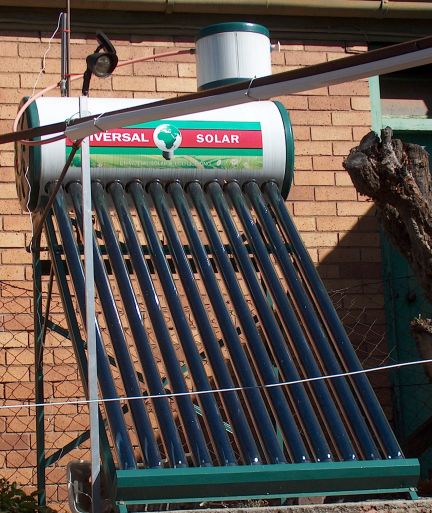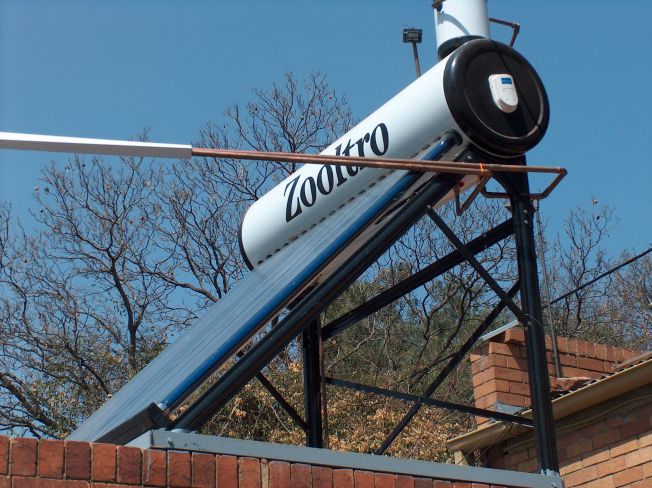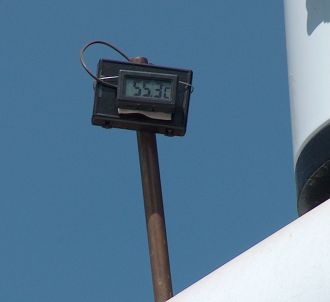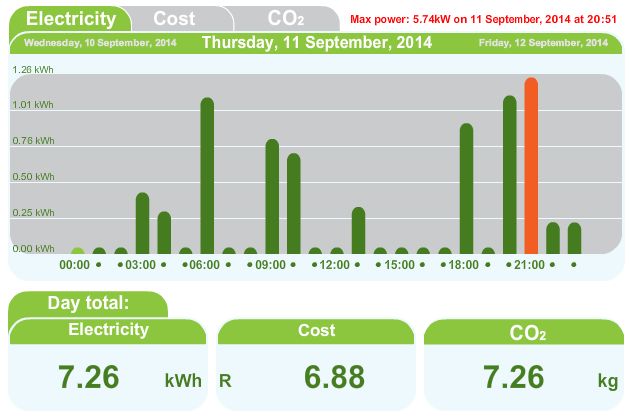

Solar Geysers - Heating water from the sun
Solar water heating - solar geysers
Heating water via a solar geyser is the most effective use of solar energy that the home owner can implement. The equipment is cheap, it is low tech and payback comes very quickly.

A low pressure solar water heater. These are very efficient in heating water. In this case the heating tubes are double walled tubes with the gap between the two tubes being evacuated. The water being heated is inside the inner tube and rises as it is heated to be replaced with colder water from the header tank. The vacuum insulation between the hot water and the outside is so effective that when you touch the tubes they feel cold. This one has a 100 litre header tank which achieves nearly 70 degrees celsius in one day sunshine. In our situation we feed this to the kitchen sink as a third feed and only switch on the electric geyser for the kitchen if there are a number of days of overcast weather.


From the same calculation, every four degree drop in temperature or a 200 litre solar geyser means that 1 kilowatt-hours energy has been transferred to the electric geyser saving the same in electricity.
In our situation, the geyser in Sept (Spring) gets to 70 degrees in the afternoon and reduces to 30 degrees after everyone has showered and bathed,
meaning it is reducing the electricity power consumption of the house by 10kwh per day.
In the high pressure solar geyser, the water in the storage tank is only use to store heat and is not consumed. This means it is suitable for situations where the geyser might encounter
temperatures below zero over night as an antifreeze can be added to the geyser water.
The following graph shows the electrical power used by two geysers that use the preheated water from the high pressure solar geyser system. The electric geysers are a 200 litre and a 100 litre system. In South Africa in Johannesburg there is a ripple relay control system that allows the municipality to switch off the geysers remotely during peak loads. This typically happens between 18h30 to 21h00 and from 07h00 to 09h00. The graph shows that for 3 adults 7.26kwh of electrical energy was used to heat the geysers in one day. This situation occured before the load scheduling program was implemented detailed below.

Solar Blankets around electrical geysers
One of the most effective energy saving devices is a geyser blanket.
We measure electrical energy daily used to keep our geysers at operating temperature.
We have a 100 litre geyser mounted outside a building - a new design of geyser that was recently replaced and so has the accepted current insulation
offered by manufacturers. When running the outer case is not hot - showing the geyser leaks minimal heat. The geyser is on a bathroom that is not used for days
and so we were able to measure the energy requirements to replace the heat losses without any consumption.
Before fitting the blanket - the geyser used 1.5kwH per day to maintain heat.
After fitting the blanket - the geyser used 1.0kwH per day to maintain heat.
Geyser blankets are very cheap, easy to fit and very effective.
Load scheduling for electric geysers
Geysers are energy storage devices and will hold their heat for a long time. By timing when to top up the heat energy one can optimise your use of solar energy. We have time switches on our geysers to try to reheat the geysers when the solar power is at a maximum so as to minimise surplus electrical power being returned to the municipality.
Getting help and advice
This description is provided to show how easy it is to get going. I am not selling anything, just encouraging users to take the first step.
You can contact me for help and advice from Mike at info@rapidttp.co.za Tel +27 72 992 6040
17 April 2023
Also see an article on Low cost solar solution
Also see an article on Design of computer controlled solar system for smart home
Also see an article on Dealing with Load shedding at home
Also see an article on Gridtie inverters -Converting solar energy
Also see an article on Stand alone inverters -Converting battery energy
Also see an article on Battery storage systems
Also see an article on Energy equivalents